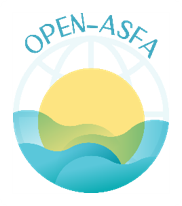Effet de la température et de la vitamine c sur la respiration du poisson <Liza aurata>
DOI:
https://doi.org/10.71754/instm.bulletin.v28.824Keywords:
Temperature effects, Vitamin C, Respiration, Liza aurata, Teleostei, Marine, TunisiaAbstract
In present study we investigate the effects of temperature increase and application of vitamin C on the respiration of the teleost fish, Liza aurata, under normoxic and hypoxic conditions. This fish is largely distributed along the tunisians cost and represents an essential aliment (food supply) for local population. Its economic importance is underlined by the existence of numerous piscicultures. The animals studied are from the Herglan bay and are of an average size of 80-160 g. Two different groups of fish were used: one was injected with vitamin C; the other, untreated group served as control. The technique used consists of measurements of respiratory parameters with an oxygen detector linked to a PC. The program "RESPI" allows the analysis of obtained data. An increase of temperature stimulates the respiratory intensity of about 62,7 °/° under normoxic conditions whereas a decrease of 56,5°/° is found after vitamin C treatment. Under hypoxic conditions the critical and lethal oxygen content enhances with an increase of temperature of 85,3°/° and 62,3°/°, respectively. Vitamin C treatment leads to a decrease of both values of 46°/° an 44°/°, respectively. In addition, an extended surviving phase under hypoxic conditions (control 11,63 min ±1,32 min; 35,70min ±3,45 min) was found for fish injected with vitamin C.












